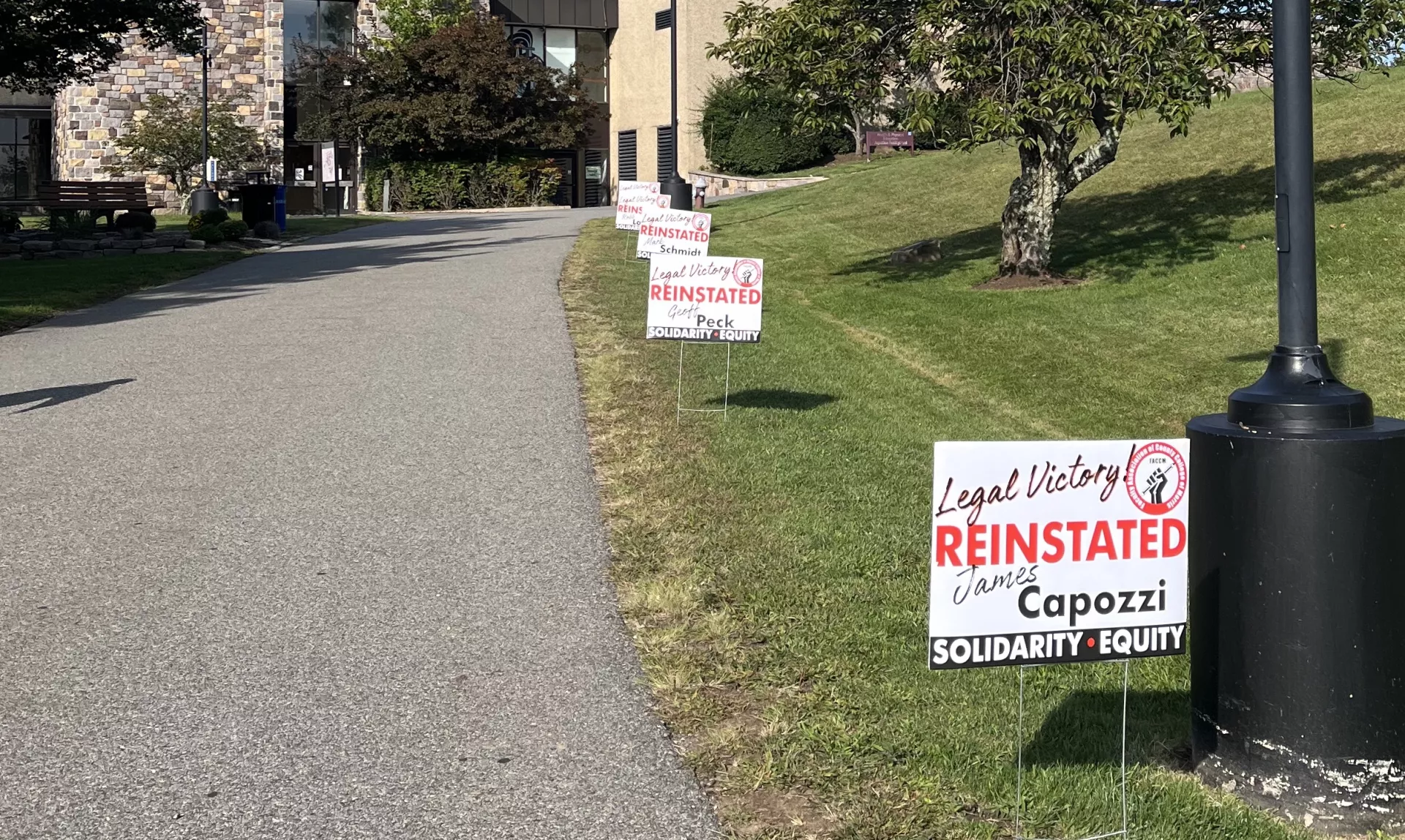Key Takeaways
- The union members were engaged in protected activities, the hearing examiner wrote. They should be reinstated to their jobs and provided with back pay.
- Union members feel vindicated! And grateful for their union's firepower. They knew all along that they'd been fired for unjust reasons.
- The campus president who orchestrated the firings is still there. This week the faculty union took a resounding vote of no-confidence in his leadership.
In April 2021, when the County College of Morris (CCM), in New Jersey, fired the faculty union president, grievance chair, communications chair, and two other active union members through a small, targeted layoff, it did not seem like a coincidence.
“We knew exactly what it was, immediately,” says James Capozzi, the former president of the faculty association of CCM.
So did a state hearing examiner, who issued a scathing 71-page ruling this month, saying the layoffs were clear retaliation for the faculty members’ vocal and visible union activities. And, as such, the firings violated state law. The faculty members were “engaged in protected activity, CCM knew of the activity, and CCM was hostile toward the Association’s exercise of protected rights,” the hearing examiner wrote. The college should offer the faculty members their jobs back and compensate them for lost pay and benefits, she recommended.
“We feel hugely vindicated by the ruling,” says Capozzi, who was a highly lauded CCM professor of English and philosophy before his dismissal. “For those of us who lived through it, it makes sense to us. Everything we knew was wrong about the college’s course of actions has been verified—and that feels good.”
The ruling also has “confirmed everything I’ve ever felt about unionism and the power of organized labor,” he says. The union was not cowed by the firings. On the contrary, over the past two-plus years, union members persevered, flexing their legal rights and representation through the New Jersey Education Association.
Now, they’ve won—and done so “spectacularly,” says current CCM faculty association president Dee McAree.
The hearing examiner was appointed by the New Jersey Public Employment Relations Commission. Now, the college has a period of time to respond to the ruling, before the entire commission decides on the case. Meanwhile, the faculty union this week took a resounding vote of no-confidence in the college president, Anthony Iocano, who orchestrated the firings and has persisted in anti-union hostility.
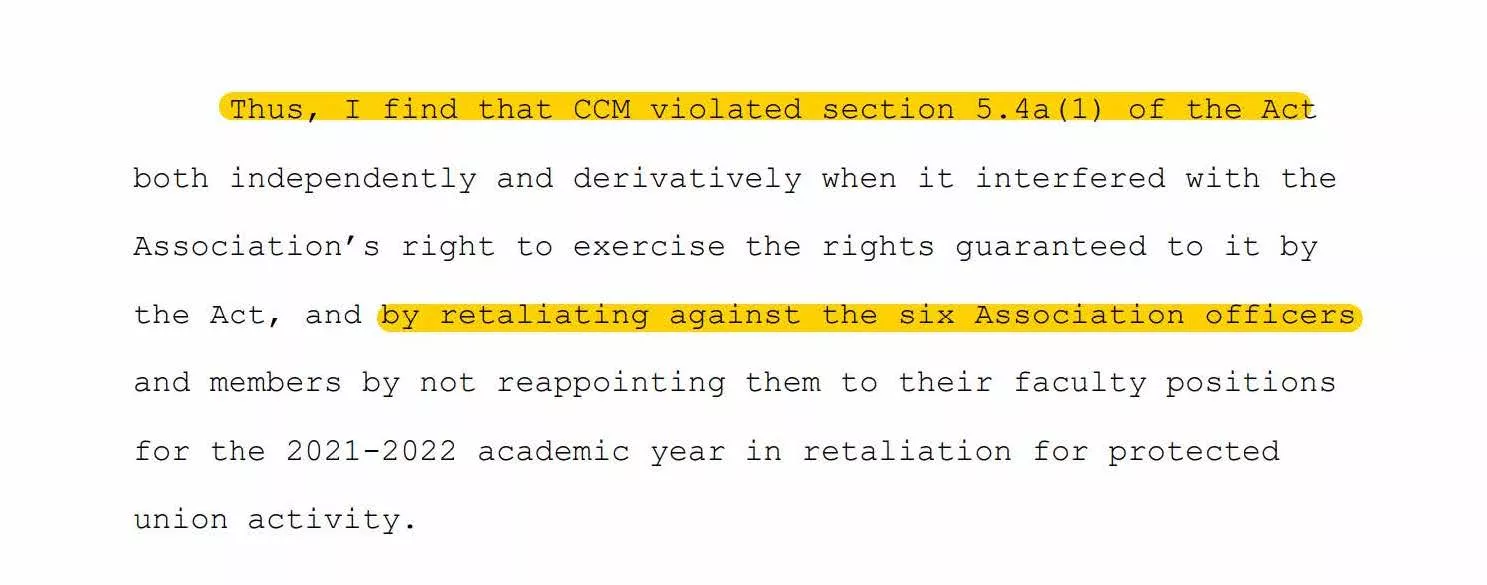
If You Cared About Students…
When Capozzi was elected as president of the Faculty Association of CCM in 2019, it was a shot across the bow for administration. Iocano had been president for a couple of years, replacing a respected Fulbright Scholar-turned-administrator who had led the college for 35-plus years—and faculty members didn’t like what they were seeing in the new administration. There was a growing sense that Iocano didn’t want to partner with faculty, through the union, and that he didn’t see faculty’s role as very important to student success.
So, faculty elected one of their best to lead them. Capozzi had been at the college for just three years but had nothing but excellent evaluations from his department chair and dean. He was an incredible teacher of students—and a natural leader of his peers, says McAree. When he was fired, it felt like “such an injustice,” she says. “Jim Capozzi had such respect. Our first instinct, when we heard, was, ‘No way.’”
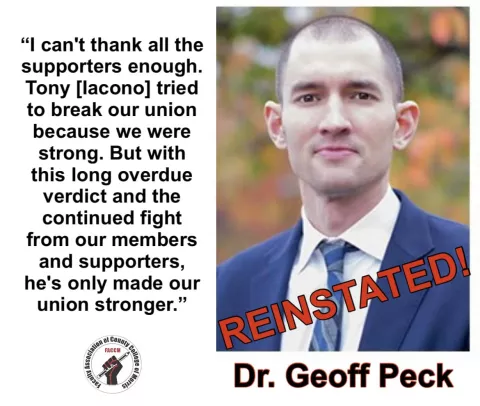
Including Capozzi, the fired faculty members were some of the college’s best educators. If you really cared about students, not only would you keep them—you’d celebrate them, says McAree. “People like Capozzi and [Geoff] Peck are just wonderful for students. To have the administration go after them? It felt like an attack on students, too,” she says. “It’s hard enough to get really talented faculty to work in a two-year college environment!”
But Capozzi and the other new union leaders had become a big thorn in Iocano’s side. They showed up together at trustees’ meetings to protect student journalists who had alleged intimidation by the administration. They asked questions about the college’s plans and response to the pandemic. Most notably, they negotiated a fantastic new contract—that provided up to 17 percent salary raises for underpaid educators—despite Iocano’s best efforts to derail the process. “He tried to insert himself in the middle of that contract, but we held together,” recalls McAree.
When the union leaders were fired, their department chairs weren’t consulted. Neither were their deans. It was shocking. But, at the same time, maybe it wasn’t. They knew Iocano hated them.
“We saw it right away for what it was: a union bust,” says McAree.
“Truly Extreme”
In the days after the firings, Iocano first said it was because of money. That reasoning didn’t make sense, however; Iocano had just told trustees that CCM was in great financial shape. A month later, CCM’s public reasons had “evolved,” notes the hearing examiner. Then, CCM acknowledged the college was financially stable, but said the layoffs were necessary to “keep it that way.”
A month after that, Iocano pointed to an obscure metric that he had instructed college staff to develop by dividing the total number of credit hours generated in a department by the number of full-time faculty members. It was a metric that Iocano applied once and only once—in the English department, in the spring of 2019. After the non-renewals, the hearing examiner notes, “the 1200 credit hour ratio analysis was never prepared again at CCM, nor was it used in any further renewal or non-renewal determinations at CCM.”
The hearing examiner’s skepticism is clear. In her report, she compares the experiences of Capozzi to another CCM assistant professor, Laura Driver. Both taught English. Capozzi had all excellent evaluations; Driver also had all excellent evaluations—except for three “good” ones. More significantly, while Capozzi was a “very active and visible Association president,” Driver deleted all mentions of the union on her career materials, at the recommendation of her dean. In 2019, when Capozzi gets terminated, Driver gets tenure. The different outcomes are “striking,” the hearing examiner notes.
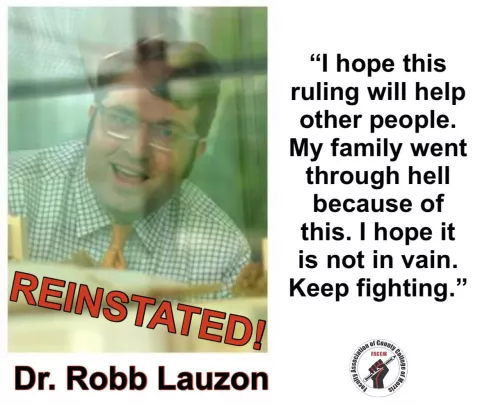
The examiner also recalls a bizarre episode when, two days after the faculty members got notice of their non-renewals, Iacono called police, claiming “someone had slashed his tires.” When officers arrived, according to the police report, Iacono fingered the laid-off professors as possible perpetrators, pointing to one in particular, Robb Lauzon, the former communications chair for the union, because he and Lauzon lived in the same town. That night, college officials called police with the educators’ contact info, prompting police to question them at home.
“The details of this entire police incident are so extreme and problematic, especially because the police report itself raises questions about whether the alleged tire slashing occurred at all,” the hearing examiner writes. Indeed, the police report says, “the tires [on Iacano’s yard cart] could have potentially ripped due to them being flat.” Police also found no footprints on the muddy ground and noted the neighbor’s dog never barked.
It is “truly extreme” that Iacono would accuse the union leaders to police, the hearing examiner writes. And “it also extremely problematic that CCM later denied…that Iacono identified Association members as suspects, in blatant contradiction to the police report,” she adds.
“The idea that I would go in the middle of the night with a ski mask to the president’s house and slash the tires on his wheelbarrow is absurd,” Lauzon told Inside Higher Ed. In fact, he had spent the weekend desperately looking for a new job and buying a suit for potential interviews.
What’s Next?
The past two-plus years have not been easy for the fired union members. The academic marketplace, especially in the wake of the COVID pandemic, isn’t exactly robust. One told Inside Higher Ed that he and his wife had been on the verge of buying a house in New Jersey when they got the call from Iocano’s underling: the couple scuttled those plans for an available job in eastern Wyoming. “If there’s a job—and it’s 1,500 or 2,000 miles away—you go, wherever it is,” says Capozzi.
Currently Capozzi is teaching online for the Virginia State University. He’d love to return to his job at CCM, where he taught composition to incoming students, plus creative writing, poetry, and more. “I dearly miss being the classroom with my students,” he says. But Capozzi does have concerns about the ongoing climate at CCM.
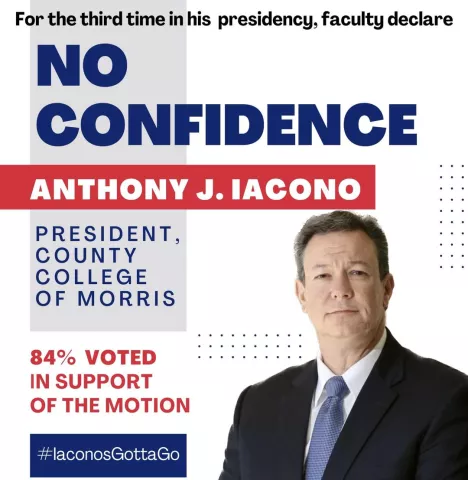
“The president is still in his position,” notes Capozzi. “The idea, that this guy—the prime mover-and-shaker in five illegal firings—is still in the big seat,” is troubling, he says. “How can the Board of Trustees say simultaneously that they have confidence in him and that they’re committed to running an institution of integrity?”
Since getting rid of the union’s former leaders, college administration hasn’t relented in its anti-union hostility, McAree says. For more than a year, faculty have been working without a contract. They remain concerned about the direction of the college and how students’ needs are overlooked. At the same time, they are determined to use their power, through the union, to make CCM a better place for faculty and students.
“Capozzi absolutely wants to come back,” McAree said. “I see my role as trying to restore a workplace that these talented faculty members—and others—would want to work in.”
